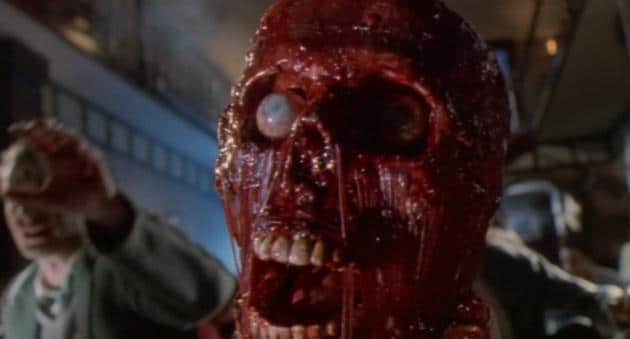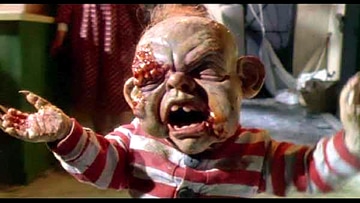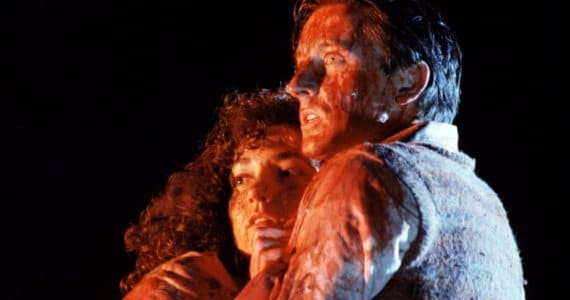 I think everyone must remember the first time they saw Dead Alive – or, to give it its UK title, Braindead, where it released in the spring of the same year (May). There are other titles in use, all of which show that distribution companies took the film very much in the spirit it was intended. As well as the expected variants on ‘braindead’, in Spain a line of dialogue from the film gives us the title, Your Mother Ate My Dog; in Brazil, they opted for Animal Hunger; Hungary, a literal nation, simply went for Corpse! (exclamation mark included). All in all, the variety of titles around the globe do a fair job of summing up the film’s plot and vibe.
I think everyone must remember the first time they saw Dead Alive – or, to give it its UK title, Braindead, where it released in the spring of the same year (May). There are other titles in use, all of which show that distribution companies took the film very much in the spirit it was intended. As well as the expected variants on ‘braindead’, in Spain a line of dialogue from the film gives us the title, Your Mother Ate My Dog; in Brazil, they opted for Animal Hunger; Hungary, a literal nation, simply went for Corpse! (exclamation mark included). All in all, the variety of titles around the globe do a fair job of summing up the film’s plot and vibe.
When I first saw the film – not long after its video release, around the time that I saw the likes of Army of Darkness and Return of the Living Dead 3 – I was already primed for films which could link black humour with grisly effects. I still wasn’t quite ready for Braindead, though; in fact, claims that it’s the goriest film ever made still ring utterly true. Using the already-familiar idea of the ‘dead undead’, director Peter Jackson takes the equally familiar idea of the living trying to escape from them, then chucks in a stack of physical comedy before absolutely drenching his sets in blood (300 litres in the final scenes alone, apparently). The film is an unparalleled piece of splatstick, so ridiculous that it’s sublime, and a demented rite of passage for so many horror fans. But apart from the unprecedented gallons of red stuff – why else do we love this film? Gore is good, but on its own it just becomes a series of grisly panels.
“SINGAIA!”
Hopefully, no one will go full pod person on me for spoilering the film if I sidestep into a quick synopsis here…but obviously, if you haven’t seen it, stop reading. Go to it.
 It’s the 1950s, and a naturalist expedition into Skull Island, Sumatra (ring any bells?) to find a specimen of a rare species – a ‘rat monkey’ – ends in a bloody incident which can’t be patched up, not even with a bit of Dettol. These little buggers are dangerous, it seems, being the warped offspring of local monkeys and slave-ship rats, and only amputation (even of the head) can be used to treat their bites successfully. Lesson duly noted. Back home in New Zealand, overbearing mother Vera divides up her time between Wellington Ladies Welfare League duties and stopping her grown-up son Lionel from growing up any more than is strictly necessary. When he starts dating a local girl, Paquita, Lionel decides to take her for a lovely day at the zoo. Vera, who isn’t too keen on her son fraternising with an Experienced Girl like Paquita, goes along to spy on them. Our rat monkey friend is by now installed and on display, but when Vera gets too close to its cage, it sinks its teeth into her, ruining her dress into the bargain. It looks as if she’s won this round, as Lionel immediately escorts his injured mother home, but she soon falls sick. Really sick. And it seems as though whatever condition she’s picked up from the monkey, it’s contagious. Lionel is one of life’s copers, but he soon loses control of the situation, despite doing what he can to keep his mother (and some unwitting houseguests) ‘calm’. Except, oh, he makes a singular error, prompting the closing sequence to end all closing sequences…
It’s the 1950s, and a naturalist expedition into Skull Island, Sumatra (ring any bells?) to find a specimen of a rare species – a ‘rat monkey’ – ends in a bloody incident which can’t be patched up, not even with a bit of Dettol. These little buggers are dangerous, it seems, being the warped offspring of local monkeys and slave-ship rats, and only amputation (even of the head) can be used to treat their bites successfully. Lesson duly noted. Back home in New Zealand, overbearing mother Vera divides up her time between Wellington Ladies Welfare League duties and stopping her grown-up son Lionel from growing up any more than is strictly necessary. When he starts dating a local girl, Paquita, Lionel decides to take her for a lovely day at the zoo. Vera, who isn’t too keen on her son fraternising with an Experienced Girl like Paquita, goes along to spy on them. Our rat monkey friend is by now installed and on display, but when Vera gets too close to its cage, it sinks its teeth into her, ruining her dress into the bargain. It looks as if she’s won this round, as Lionel immediately escorts his injured mother home, but she soon falls sick. Really sick. And it seems as though whatever condition she’s picked up from the monkey, it’s contagious. Lionel is one of life’s copers, but he soon loses control of the situation, despite doing what he can to keep his mother (and some unwitting houseguests) ‘calm’. Except, oh, he makes a singular error, prompting the closing sequence to end all closing sequences…
“They’re not dead… exactly…”
Firstly, you’d have to really go some to see the kind of social commentary here which writers are so happy to pick out of almost anything horror-related these days, particularly if dead (or otherwise zombified) creatures are wandering around. I mean, if you put your mind to it, you could come up with something relating to the monstrous feminine, but by and large, the film sets out its lack-of agenda before the opening credits roll: the fact that limbs are being lopped off and the title on screen physically comes out of this OTT sequence surely tells us that. Sure, there are some messed up relationships in the film, but they’re fairly quickly escalated into something comprehensively and joyously detached from reality – and that’s okay, it’s good to park your brain at the door and enjoy a film which is completely unreal and cartoonish from time to time. If the film has any central message it’s that ‘life comes at you fast’, and poor Lionel’s attempts to keep normality ticking over are hilarious, excruciating and ill-fated. Yes, he gets the girl at the end, but only after going through a houseful of party guests with a lawnmower.
Things certainly do go badly wrong at home for our homebody main character, though. Jackson’s early films (Bad Taste and Braindead in particular) take great pleasure in turning an average house into something going catastrophically wrong and he seems to have a particular knack for making mealtimes disgusting. Passing around the ‘gruel’ in Bad Taste was vile enough; the dining table scene in Dead Alive is a masterclass in stomach-turning awkwardness, this time swapping the gruel for an everyday dessert. Vera’s frantic attempts to host a delightfully middle-class WLWL gathering, despite her body parts starting to fall off, result in that repellent, hilarious sequence where an oblivious and very easily-pleased Mr. Matheson tucks into a bowl of pus-filled but otherwise “damn fine” custard. The whole thing is laugh-out-loud funny, brilliantly acted by the late Elizabeth Moody (“Thank……you…No…ra”) and it’s a kind of horror-infused Keeping Up Appearances (a British sitcom about social snobbery – honestly, the parallels are there). Elsewhere, moments which are meant to be very sad (such as Vera’s ‘passing’) segue immediately into head-shredding gore, and the riotous false ending involving the ‘tranquiliser’ subverts the whole mood of the quieter scene which comes before it. You never get to relax in this film, and nor would you want to, making it one of the best splattery comedies out there – and the quaint, old-fashioned setting of 50s New Zealand acts as a neat foil and a perfect contrast to the absurd developments we see on screen.
 More than this, Dead Alive is confident enough in itself to do a few new things with the idea of the zombie. Lionel has his hands full with the little house gathering he ends up with, but probably didn’t expect to have to contend with two of them falling for each other. The only people consummating anything in the film are corpses; weirder still, these corpses end up doting on a new arrival soon afterwards. Cinema had brought us monster offspring, but never clowning like this. Parenthood doesn’t exactly get an easy run in the film, at any point, and forging the guise of a happy family gives us one of the film’s most outrageous scenes. Baby Selwyn – with Lionel haplessly trying to look after him – gives us the best parody of the proud parental walk in the park, probably ever, especially when Lionel starts punching the little bleeder before shoving him in a duffle bag, under the astonished eye of a gathering of genteel looking women. “Hyperactive,” apparently. There’s still a shock value in having a character doing anything to ‘The Children’, even if one of them is a zombie, so this is another expectation Jackson plays fast and loose with, as well as showcasing Timothy Balme’s tremendous skills as a decent man on the edge of losing his mind. When I first saw the park sequence, I had to watch it again straight away. I wasn’t sure if I had really seen a man doing that with/to a pram. (I re-watched the sequence to write this feature, and yep, it’s still enough to make me cry laughing. I mean, how could you not?)
More than this, Dead Alive is confident enough in itself to do a few new things with the idea of the zombie. Lionel has his hands full with the little house gathering he ends up with, but probably didn’t expect to have to contend with two of them falling for each other. The only people consummating anything in the film are corpses; weirder still, these corpses end up doting on a new arrival soon afterwards. Cinema had brought us monster offspring, but never clowning like this. Parenthood doesn’t exactly get an easy run in the film, at any point, and forging the guise of a happy family gives us one of the film’s most outrageous scenes. Baby Selwyn – with Lionel haplessly trying to look after him – gives us the best parody of the proud parental walk in the park, probably ever, especially when Lionel starts punching the little bleeder before shoving him in a duffle bag, under the astonished eye of a gathering of genteel looking women. “Hyperactive,” apparently. There’s still a shock value in having a character doing anything to ‘The Children’, even if one of them is a zombie, so this is another expectation Jackson plays fast and loose with, as well as showcasing Timothy Balme’s tremendous skills as a decent man on the edge of losing his mind. When I first saw the park sequence, I had to watch it again straight away. I wasn’t sure if I had really seen a man doing that with/to a pram. (I re-watched the sequence to write this feature, and yep, it’s still enough to make me cry laughing. I mean, how could you not?)
This really is the film which has it all, if you like seeing gore layered on top of gore and a pitch-perfect script. Never mind the meticulous cinematic metaphors – there’s a time and a place for all of that. Dead Alive blends pratfalls, ingenious, imaginative gruesome effects, engaging characters (yeah, even Uncle Les) and a novel set up which plays out in an unexpected way. It’s sheer, farcical entertainment throughout. I suppose, in the end, the whole thing is about a sheltered young man eventually making decisions for himself. It’s just that, to get to that point, he has to be absorbed into the monstrous womb of his recently-resurrected giant jealous mother, then carve his way out of there. So, okay, if you really want to go down the social commentary route, I suppose you could, but there’s more than enough to just stick to the entertainment value here.
I’ve always felt surprised that the guy who directed the likes of Dead Alive and Meet the Feebles eventually went on to make Lord of the Rings and I said as much when I wrote a retrospective about Bad Taste, but perhaps it’s not that staggering after all although the different-era films are, shall we say slightly different in tone. Jackson has a history of aiming big and bold, even from the very earliest point in his career, and his horror/exploitation offerings can certainly still hold their own, even against a new wave of films which were surely influenced by the unhinged overkill of Jackson’s early years. And, twenty five years on, this film is as brilliant and irreverent as ever; it’s far, far more than just a gag reel, but its gags and its one-liners have definitely stood the test of time.
